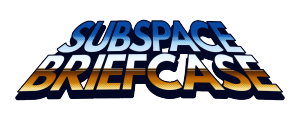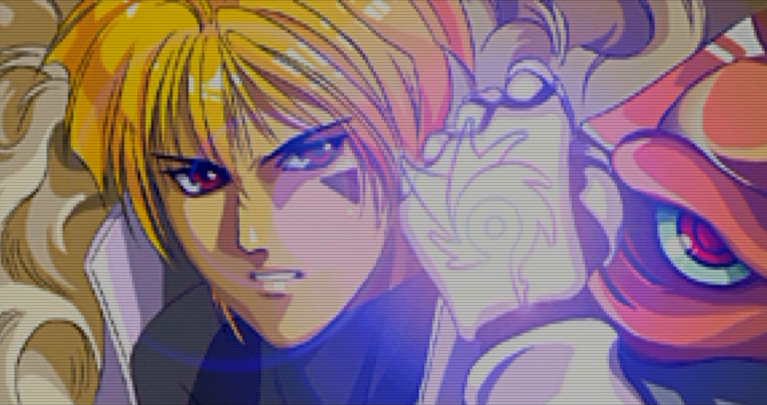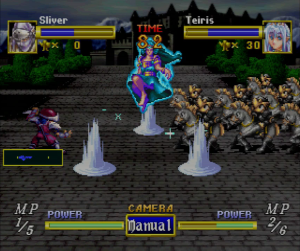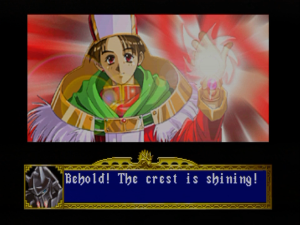Released to western audiences in November of 1996, Dragon Force is one of the Sega Saturn’s true classics. While it would not be incorrect to call Dragon Force a real time strategy game, its unique brand of gameplay truly defies traditional genre classification. It’s a one of a kind experience[1] that exemplifies the unconventional, “outside of the box” qualities that endeared Saturn owners to Sega’s console even as it was eclipsed by its generational rivals.
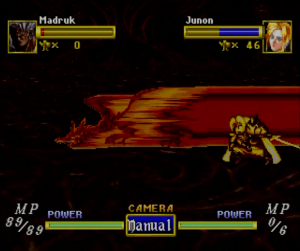 Dragon Force tells a *relatively* simple fantasy story of a divided continent on the precipice of a demonic invasion. 300 years ago,[2] the continent of Legendra was besieged by the dark god Madruk. Legendra was saved only by the appearance of the Star Dragon, Harsgalt, who emerged to challenge Madruk. While Harsgalt was victorious, he was unable to slay Madruk, merely seal him away. 300 years later, Madruk is poised to break that seal, and it falls on the eight members of the Dragon Force, who have inherited Harsgalt’s power, to unify the continent and brace for Madruk’s awakening. The player assumes the role of one of the eight playable members of the Dragon Force – more often than not, the only one who is aware that he or she actually is a member of the Dragon Force. The player must lead an army to conquer Legendra in an effort to locate the other seven members of the Dragon Force and bring stability to the land before Madruk reawakens.
Dragon Force tells a *relatively* simple fantasy story of a divided continent on the precipice of a demonic invasion. 300 years ago,[2] the continent of Legendra was besieged by the dark god Madruk. Legendra was saved only by the appearance of the Star Dragon, Harsgalt, who emerged to challenge Madruk. While Harsgalt was victorious, he was unable to slay Madruk, merely seal him away. 300 years later, Madruk is poised to break that seal, and it falls on the eight members of the Dragon Force, who have inherited Harsgalt’s power, to unify the continent and brace for Madruk’s awakening. The player assumes the role of one of the eight playable members of the Dragon Force – more often than not, the only one who is aware that he or she actually is a member of the Dragon Force. The player must lead an army to conquer Legendra in an effort to locate the other seven members of the Dragon Force and bring stability to the land before Madruk reawakens.
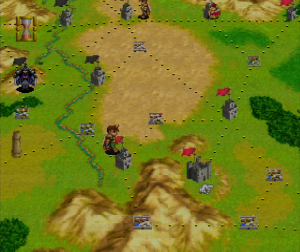
Each “week” of gameplay time is divided into two phases: a “strategic phase” where the player moves their armies and fights opposing forces, and an “administrative phase” where the player manages his generals and fortifications. The strategic phase is where the meat of the game takes place, as the player moves his armies across the world map[3] in an effort to conquer enemy fortifications and defend his kingdom from invading forces. Armies in Dragon Force are comprised of groups of generals, each of whom can command up to 100 troops when fully leveled. When two 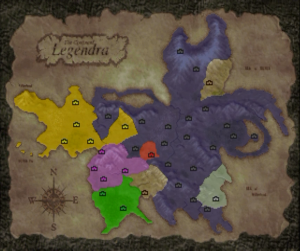 armies collide, Dragon Force switches to a side-view of the battlefield, and sprite based carnage ensues. The player selects the starting formation of his troops, and as the battle progresses, he can command those troops to move around the battlefield as he sees fit. With upwards of 200 sprites moving around the battlefield at any one moment, Dragon Force really showcases the Saturn’s 2D capabilities.
armies collide, Dragon Force switches to a side-view of the battlefield, and sprite based carnage ensues. The player selects the starting formation of his troops, and as the battle progresses, he can command those troops to move around the battlefield as he sees fit. With upwards of 200 sprites moving around the battlefield at any one moment, Dragon Force really showcases the Saturn’s 2D capabilities.
Adding a little more sizzle to the proverbial steak, Dragon Force offers 10 distinct troop types, ranging from rank and file infantry to mythical beasts, each with their own strengths, weaknesses, and terrain effects, creating a staggering amount of matchups. Further, throughout the course of the game, the player can acquire well-over 100 generals, each of whom has three separate special attacks which can impact a battle in a number of different ways. Pairing the right general with the right troop type can completely subvert otherwise insurmountable odds.
Each victory earns the player an “award” which can be bestowed upon one of his generals during the administrative phase. Each award allows its recipient to command ten additional troops. While awards can be bestowed upon any general in your force, if you fail to promote a general after they win a battle, they may become disgruntled, and defect from your army. While this rarely has any meaningful impact on gameplay, it does add a nice little wrinkle to the game’s character progression system.
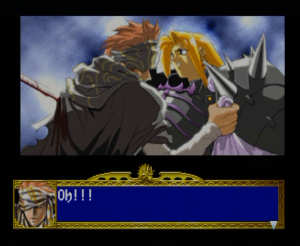
While it would be generous to call Dragon Force’s plot anything other than “serviceable,” it’s bolstered by a colorful translation from publisher Working Designs. While most generals only have a handful of lines, the famed translation house managed to fill them with as much personality as possible.[4] Key story elements are also accompanied by beautiful, hand drawn still frames which go a long way towards giving the story a sense of gravitas.
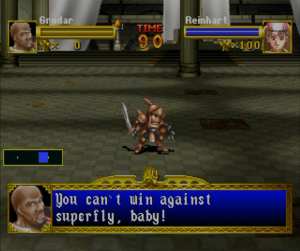
It’s difficult to find much fault with Dragon Force’s classic 2D visuals. On the battlefield, troops and generals are represented by large, expressive sprites. While the frames of animation for each individual character are somewhat limited, this deficiency is offset by the sheer spectacle of seeing upwards of 200 troops duke it out in real time simultaneously. Backgrounds are colorful and varied, and massive spell effects leap off the screen with colorful ferocity.
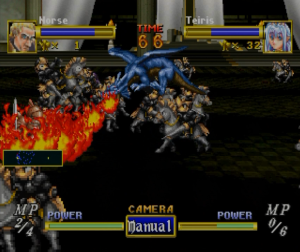
Sound and music are more than competent, if not a little repetitive. Each monarch has their own personalized overworld theme, and the music which accompanies story sequences and battles is atmospheric and appropriate. The game’s main theme is an exuberant standout, but a little more variation would have been welcome, particularly given the fact that your average Dragon Force playthrough can last over 20 hours – if you want to try out more than one of the monarchs, you might want to download some podcasts before you begin.
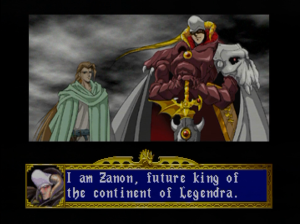
If Dragon Force has any one significant flaw, it’s that that its average turn length can run a little long. Gameplay can only be saved during the administrative phase, and with over one hundred generals who can fight multiple battles in a single strategic phase, sometimes you’ll be waiting for hours at a time between save points. This is slightly mitigated by the fact that you can “suspend” gameplay mid turn if you have a functioning Saturn memory cart – a luxury that is increasingly short supply in this day and age.
Dragon Force is a true Saturn classic; a game that really showcases the console’s strengths as a 2D workhorse. It feels like it simply could not have been done on the PSX or N64. At the time, it was all you could have asked for in a platform exclusive, and its gameplay is still compelling today. If you’ve got the means to play it, I strongly suggest that you do.
[1] Not exactly. There is a sequel that has yet to receive an English translation, official or otherwise.
[2] Amazingly, most of the people of Legendra seem to have forgotten all of this relatively recent history by the time the game begins.
[3] The map of Legendra is not unlike a board game, and the player’s armies are the pieces. While the pieces move in real time, they can only move along pre-defined routes on the map.
[4] One should note that this might be considered a negative, depending on your general feelings regarding Victor Ireland’s sense of humor.
